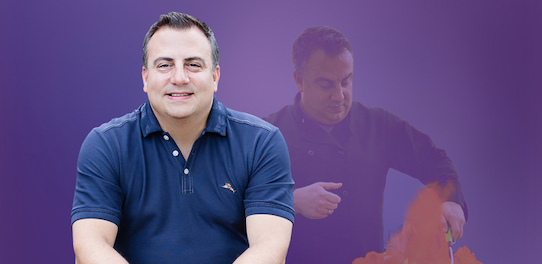GlobalMeet’s Frank Paterno explores all the options
Frank Paterno is the senior vice president of marketing and customer success at GlobalMeet, a scalable, flexible and secure event solution built and backed by event professionals who have extensive experience in facilitating engaging and accessible virtual and hybrid events. We had a Zoom meeting with Frank recently to get his thoughts how virtual and in-person events can work together to enhance an organization’s meetings strategy. Here’s what he had to say.
MeetingsEvents: The pandemic really established virtual meetings as a viable option to face-to-face events. Now that in-person meetings have returned, what is the state of virtual events? Is it now seen as a hybrid tool, or is it still a viable option for replacing some face-to-face events?
Frank Paterno: Pre-pandemic, I would say the virtual event space probably had a bit of an adversarial relationship with face-to-face events. Back then it was in-person or virtual. Through the pandemic, I think we all learned to get along. Basically, there are three categories of how virtual and in-person events interact with each other. It’s either replace, extend, or supplement.
Replace a live event with a virtual one. An organization that previously had an in-person event, moves the entire meeting to virtual and eliminates in-person planning and all the costs that go with it. Of course, through the pandemic, everybody did that. And now, most organizations have moved back to in-person events. So, today the question organizations have to ask is: What makes a better option for our group, in-person or virtual?
1. Budget is one consideration. When you have a need to meet and you don’t have the budget for an in-person, rather than skip it, a virtual event makes a pretty good option.
2. What is more important to the event content or networking? When the content is more important than the networking aspect, a virtual event could actually be better. It allows attendees to absorb the information at their own pace, even to the point of re-watching the session if necessary.
3. Another issue that goes along with a content heavy event is how comfortable your speakers are with getting up in front of a live audience. With highly technical communities, medical, scientific, even some financial, when the speakers have something very important to say, but they’re not public speakers putting them on stage in an auditorium or at a trade show or at even an internal conference can sometimes be disastrous. Their brilliant message can get lost because they’re so uncomfortable in front of an audience. Getting that brilliant scientist, or company CFO in their own comfortable space in front of a webcam is less scary.
4. The last one is timeliness. There’s a lot of customers that we’ve seen need to throw up a virtual event to discuss something that’s gone on. It could be the failure of Silicon Valley Bank and the impact on an investor community, or it could be geopolitical things going on and any kind of industry needing to bring together a community to talk about it. It could be their employees, it could be their customers, it could be their investors. I think we’re finding virtual events can break down the time barrier.
Extending an in-person event. This would be a situation where an organization will combine face-to-face and virtual platforms to create a hybrid event. I’ve got a couple of thoughts where this can be very beneficial.
1. There were a lot of parts of the world that got to participate in virtual events during the pandemic that historically have not been able to participate in face-to-face events because they don’t travel well for either distance, financial, safety, political reasons. Generally these are south of the equator destinations like South America, Africa, and certain parts of Asia. During the pandemic when everybody came together, a lot of event planners saw their audiences grow because this whole new audience suddenly became accessible. Now that face-to-face has come back organizations don’t want to exclude those communities anymore. That’s one of the biggest hybrid event usages that we’re seeing.
2. The other use for virtual is to extend the life of an event. Now, a three-day sales kickoff or a two-day training meeting can be streamed while it is happening and also captured digitally. So now organizations can either take that entire event and make it available on demand or break out specific sessions and make them available online. This also gives the show organizers the ability to clean them up, edit them, take away that thing that the CEO shouldn’t have said, maybe take out some parts that were dragging and create a succinct version of what happened.
Supplement an event. Perhaps your budget only allows your organization to host an annual event. Or maybe many of your potential attendees only have time to go to that event once a year. Rather than wait an entire year to get that community back together again, you can supplement that annual in-person event with monthly or quarterly virtual events. The annual event would bring everyone together for networking and the series of virtual events bring them back together for content reinforcement and deeper dives into things that were covered that can foster the relationships that were created face-to-face.
MeetingsEvents: When virtual is used in a hybrid event capacity, how is it changing the expectations of what organizations and attendees expect from a live event that includes a face-to-face component?
Frank Paterno: In the past when attendees went to live events, they really had to make a choice between networking and attending sessions. Hybrid events have freed them from that choice to a great extent.
1. Now they can attend the networking events while they are happening and access the educational sessions at a later date. Through the usage data we gather from our hybrid events we can actually see people engaging with the on-demand sessions in between networking opportunities in the afternoons and the evenings during the conference. On-demand content is allowing people to have it all and do multiple things, that’s one expectation.
2. The virtual audiences are also demanding more, they’re not okay with being left out anymore. So if you are going to extend that session and broadcast those sessions to virtual audiences, you need to give them a way to interact with the speakers. At the very least, let them type in a question and maybe have somebody there on site that’s reading the question. The technology is also there to bring a virtual moderator on the screen and who identifies the virtual attendee by name and has them ask the question themselves. There’s no reason to not have that and be able to have the virtual version of passing the mic around a room for questions.
3. It is now common practice for shows to have an event app that allows in-person attendees to network and make appointments with exhibitors and other attendees. Now, once you’ve done that, now you’ve created an environment to bridge in the virtual attendees. Because if someone finds value as an in-person attendee to use the app in order to engage with vendors, engage with other people now, they could just as well be chatting or setting an appointment with somebody virtually.
4. We also have had several customers that are using the virtual event technology for in-person attendees. As an attendee walks into a keynote session, they can scan a QR code that puts them into the virtual platform for the session but it puts them in as an in-person attendee. That means that as the presenter is sharing slides the attendee can view at the slides in the app rather than look at the screen onstage. And of course it’s possible to launch an audience poll or some other kind of engagement that can also be captured for on demand as well. So that’s kind of interesting. Overall I think attendees are expecting the lines to be blurred a bit and they’re expecting technology to help them wherever they are.
Any thoughts, opinions, or news? Please share them with me at vince@meetingsevents.com.





